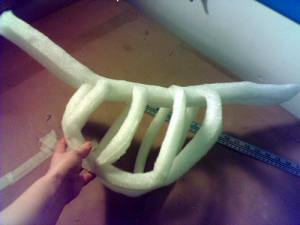|
 For a new show at Rattlestick Theater, I’m building a wounded springer spaniel. To start, I drew out a scale drawing of the dog for a pattern, which I then traced onto ethafoam. The piece here is Lady’s spine from the base of her neck to the tip of her tail. I build the curvature that I want into the shape of the foam so that it wants to return to this as its natural position. For a new show at Rattlestick Theater, I’m building a wounded springer spaniel. To start, I drew out a scale drawing of the dog for a pattern, which I then traced onto ethafoam. The piece here is Lady’s spine from the base of her neck to the tip of her tail. I build the curvature that I want into the shape of the foam so that it wants to return to this as its natural position.
|
|
 One of the beautiful things about ethafoam is that you can heat weld it. The Puppet Kitchen, where I was working, has a ventilation hood so that I can work with relative safety while doing this. I also wear a respirator because heat welding basically involves melting foam together. It releases all kinds of nasties. One of the beautiful things about ethafoam is that you can heat weld it. The Puppet Kitchen, where I was working, has a ventilation hood so that I can work with relative safety while doing this. I also wear a respirator because heat welding basically involves melting foam together. It releases all kinds of nasties.
This might be one of the reasons that I try so hard to be environmentally conscious in the rest of my life, because my job is so frequently not nice to the planet.
But heat welding is really cool and makes for strong lightweight puppets.
|
|
 With the other rib pieces cut and welded on, Lady begins to take shape. One of my major challenges with this project is that she has to breathe. The way the action is described in the script, getting a puppeteer to her will be challenging to say the least. With the other rib pieces cut and welded on, Lady begins to take shape. One of my major challenges with this project is that she has to breathe. The way the action is described in the script, getting a puppeteer to her will be challenging to say the least.
She’s carried onstage and then set down on the ground..
Remote control is not a real option because of the vast number of cabs in NYC but more specifically because we’re down the street from a hospital. The amount of interfering signals floating through the ether would send any r/c puppet into seizures.
Trailing cables… not so pretty. What we’ll probably wind up doing is having the actor carrying her in do some minimal puppetry and then try to get a puppeteer under the ground to keep her alive. This is a good example of one of the reasons why the puppet designer often wants to have input into the set design. We sometimes need the designer to build in places to hide the performer.
|
You couldn’t put some kind of battery-powered gizmo in there? Then somebody just turns the lungs on and goes.
(A humble suggestion from the peanut gallery – feel free to flog me with a wet noodle if inappropriate)
Rule number one in theater, there is no “just,” as in “couldn’t you just…” Granted, I’ve never met a director who knew that rule, but you know, I always hope.
In this case, yes, I could put a battery-powered gizmo in there but the dog is supposed to be wounded. How regular do you think the breathing of a wounded dog is? For that matter, how regular is breathing in general? One of the reasons respirators are so freaky is that the person on them has precisely regular breaths.